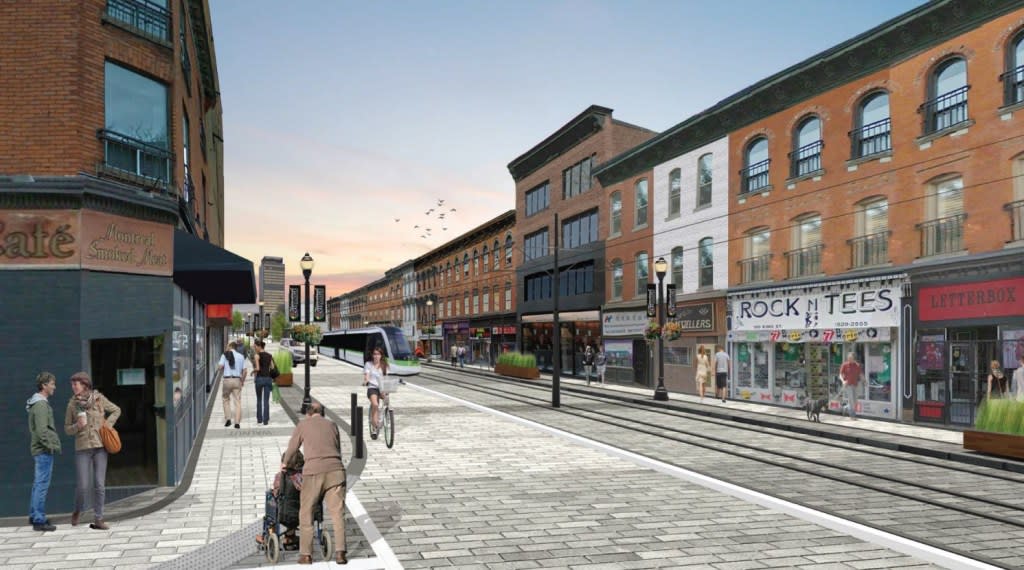Hamilton light rail transit project makes another move forward
Hamilton City Council approves agreement to move ahead. Here’s what it means and where it can lead.
Oct 16, 2022
The Hamilton light rail transit (LRT) project has taken another step forward.
Today (Sept 15), Hamilton City Council ratified their decision to re-initiate the project that will bring 14 kilometres of new rapid transit to the city.
They authorized the Mayor and City Manager to sign an agreement that will allow Metrolinx and its partner, the City of Hamilton, to re-initiate the transit project. Metrolinx will now work with the City of Hamilton to establish a project team and collaboratively progress into procurement and delivery of the project.
"“The B-Line LRT will be the spine of Hamilton’s future transit system, improving local transit options and modalities, and reducing congestion.”"- Keanin Loomis, President and CEO of the Hamilton Chamber of Commerce
The Hamilton LRT project is important for Hamilton as the city continues to grow. The transit project will connect McMaster University in the west to Eastgate in the east. The 17-stop LRT line will integrate with local HSR bus service, and connect with local bike share, and GO bus and rail service at the Hamilton GO Centre.
A closer look at the Hamilton LRT mapDOWNLOAD
New, modern light rail vehicles will run along tracks separated from regular traffic and will offer frequent, reliable and safe service.
The line will not only help people get to where they need to go but will also include a significant investment in public infrastructure. These include roads, sidewalks, bridges, watermains, sewers, electrical distribution (hydro), telecommunications, natural gas, traffic control signals and streetlights.
A light rail vehicle makes its way down a Hamilton street in this artist concept. (Metrolinx photo)
The Hamilton LRT project will also bring jobs to the community through employment and training opportunities. In conjunction with the Hamilton Community Benefits Network, a community benefits framework will be set out to ensure jobs are available to local suppliers, apprenticeships, contractors and suppliers.
“The B-Line LRT will be the spine of Hamilton’s future transit system, improving local transit options and modalities, and reducing congestion,” said Keanin Loomis, President and CEO of the Hamilton Chamber of Commerce.
“Moreover, the transformative potential of this major infrastructure investment will provide 7,000 jobs for Hamilton and neighbouring municipalities, that will in turn boost our post-pandemic economic recovery.”
The Hamilton light rail transit project is not new to the transit conversation. In 2021, a joint funding announcement was made by the provincial and federal governments where they committed $3.4B to the capital cost of the project, making the Hamilton LRT one of the largest infrastructure investments in the city’s history.
Looking for more information on the Hamilton LRT project? Just go here.
Hamilton LRT project quick facts
What are the benefits of LRT in Hamilton?
- Better accommodate future travel demand and build healthier, more sustainable communities by encouraging the development of mixed-use, higher density communities.
- Support city growth by building transit to prepare for Hamilton’s expected increase of population to 780,000 by 2041.
- Include significant investment to both public and private infrastructure such as roads, sidewalks, bridges, water mains, sewers, electrical distribution (hydro), telecommunications, natural gas, traffic control signals and streetlights.
- Contribute to economic uplift by attracting long-term development and investments.
- Provide new local jobs through employment and training opportunities and apprenticeships.
- Contribute to an efficient and integrated public transit system for all users by being the first of a network of rapid transit lines, known as the BLAST Network, that are proposed for Hamilton. With an annual ridership of 9.2 million each year, this corridor is the most used of any within the city.
- Provide improved frequency, reliability and increased service hours with trains running operating in their own dedicated right-of-way.
- Be clean and green with no emissions from the vehicle, which reduces air pollution and contributes to cleaner air.
- Be accessible due to low floor level boarding with multiple doors, so strollers and mobility devices can easily roll on and off.
Early works construction on the project (such as utility relocations) are expected to begin in early 2022, and there will also be visible work on the corridor this fall as demolitions of vacant properties continue. To learn more about the project and to stay up to date on all the latest Hamilton LRT project news, follow the project on Twitter and sign up to the project newsletter.
by Erika D’Urbano Communications senior advisor
